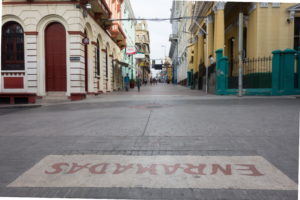 SANTIAGO DE CUBA CUENTA SU HISTORIA. LA CALLE ENRAMADAS. PHOTOS.
SANTIAGO DE CUBA CUENTA SU HISTORIA. LA CALLE ENRAMADAS. PHOTOS.
En unos pocos dias Santiago de Cuba cumplirá 504 años de fundada por Diego Velazquez, siendo una de las primeras en ser convertida en capital de Cuba. Sus calles son emblemas de tradiciones y leyendas dignas de ser mencionadas por sus originalidades.
Una de ellas es la calle ‘Enramadas” es la más populosa de la ciudad de Santiago de Cuba y si lo duda basta con detenerse a cualquier hora del día para apreciar el ir y venir de la gente, en una arteria de intensa vida comercial y gastronómica.
Fue bautizada así cuando a mediados del siglo XVIII la población religiosa de la localidad inició las procesiones por el céntrico trayecto, rumbo a la iglesia catedral, y los vecinos construyeron enramadas de guano y de otras plantas para adornar y también mitigar el fuerte sol.
Mucha historia encierra cada esquina que mira a Enramadas como, por ejemplo, la intersección con Carnicería, donde estuvo una picota pública para castigar a los esclavos rebeldes durante el sistema colonial de la época.
Con los siglos se convirtió en la principal vía de la urbe, ya que desde la Plaza de Marte hasta Santo Tomás abundaban las unidades de servicios.
Precisamente uno de los proyectos en marcha por el medio milenio de la fundación de la villa de Santiago de Cuba, el 25 de julio próximo, prevé abrir desde Santo Tomás hasta la Avenida Jesús Menéndez otros establecimientos con variadas ofertas para la población.
Se trata de reanimar la totalidad del paseo para beneficiar la parte baja de la urbe, donde variadas propuestas ampliarán las opciones recreativas para niños, jóvenes y adultos.
En esa arteria se inspiró décadas atrás el compositor Pedro Gómez y puso la letra en manos del maestro Adalberto Álvarez, entonces al frente del conjunto Son 14.
Una de sus estrofas reza así: “Calle Enramadas mayor/ novia de nuestra ciudad/ populosa arteria principal de mi Santiago. Me gusta ver, al calor el sol ardiente/ la sonrisa de la gente felices al caminar.

Ayer, Hoy, Siempre- www.THE CUBANHISTORY.COM-Yesterdays, Today, Always.
 SANTIAGO DE CUBA TELLS ITS HISTORY. THE “ENRAMADAS” STREET. PHOTOS.
SANTIAGO DE CUBA TELLS ITS HISTORY. THE “ENRAMADAS” STREET. PHOTOS.
In a few days, Santiago de Cuba will be 504 years old founded by Diego Velazquez, being one of the first to be converted into the capital of Cuba. Its streets are emblems of traditions and legends worth mentioning for their originality.
One of them is the street ‘Enramadas’ is the most populous of the city of Santiago de Cuba and if you doubt it is enough to stop at any time of the day to appreciate the comings and goings of the people, in an artery of intense commercial life and gastronomic
It was baptized that way when in the middle of the 18th century the religious population of the town began the processions along the central route, towards the cathedral church, and the neighbors built guano and other plants to decorate and mitigate the strong sun.
A lot of history surrounds every corner that looks at Enramadas as, for example, the intersection with Carnicería, where a public pillory was to punish rebellious slaves during the colonial system of the time.
Over the centuries it became the main road of the city since from the Plaza de Marte to Santo Tomas the service units abounded.
Precisely one of the projects underway for the half millennium of the founding of the town of Santiago de Cuba, on July 25, plans to open from Santo Tomás to Jesus Menéndez Avenue other establishments with varied offers for the population.
The aim is to revive the entire walk to benefit the lower part of the city, where varied proposals will expand the recreational options for children, youth and adults.
In that artery, the composer Pedro Gómez has inspired decades ago and put the lyrics into the hands of maestro Adalberto Álvarez, then at the head of the Son 14 ensemble.
One of his stanzas reads as follows: “Calle Enramadas mayor/girlfriend of our city / populated main artery of my Santiago. I like to see, to the heat the burning sun / the smile of the happy people when walking.
Agencies/ Wiki/ ACN / Marlene Montorya/ Internet Photos/ Arnoldo Varona/ www.TheCubanHistory.com
THE CUBAN HISTORY, HOLLYWOOD.

Ayer, Hoy, Siempre- www.THE CUBANHISTORY.COM-Yesterdays, Today, Always.



 < SANTIAGO DE CUBA Tells its History. The "Enramadas" Street. PHOTOS.
< SANTIAGO DE CUBA Tells its History. The "Enramadas" Street. PHOTOS.



